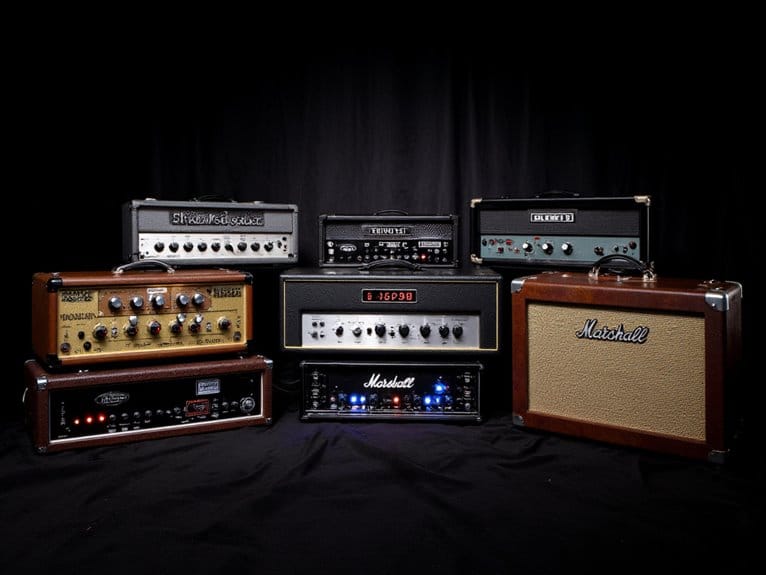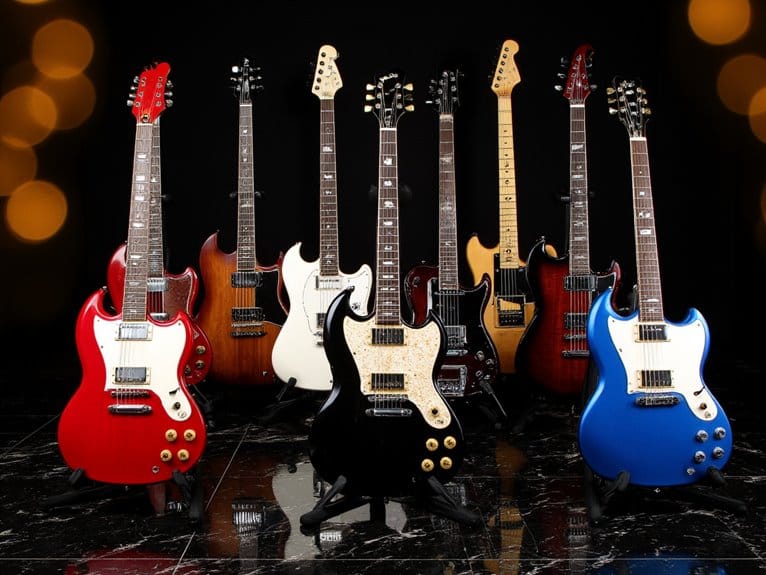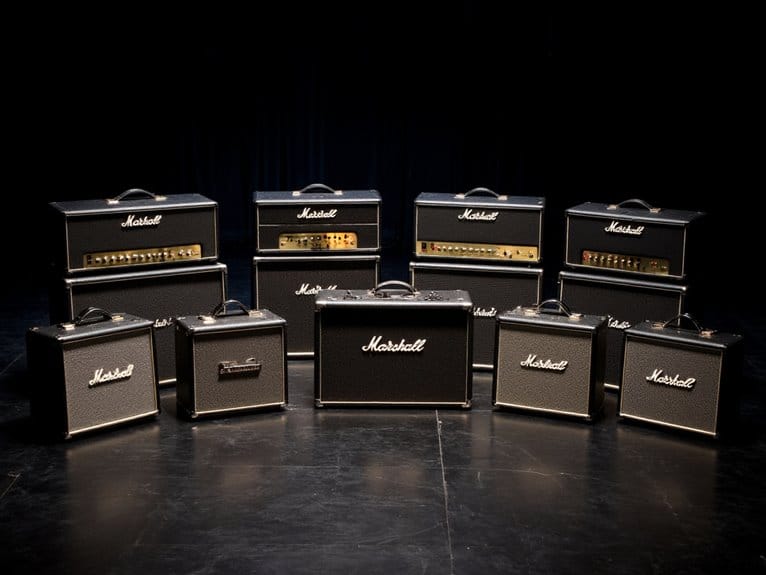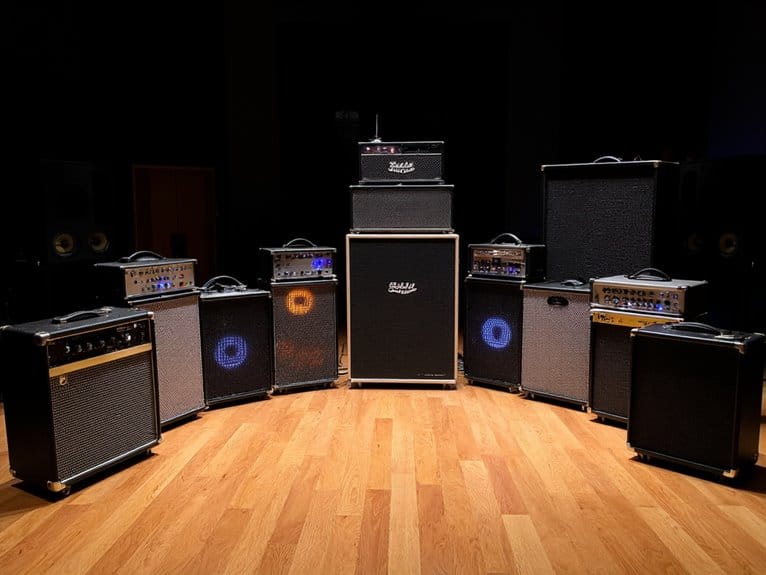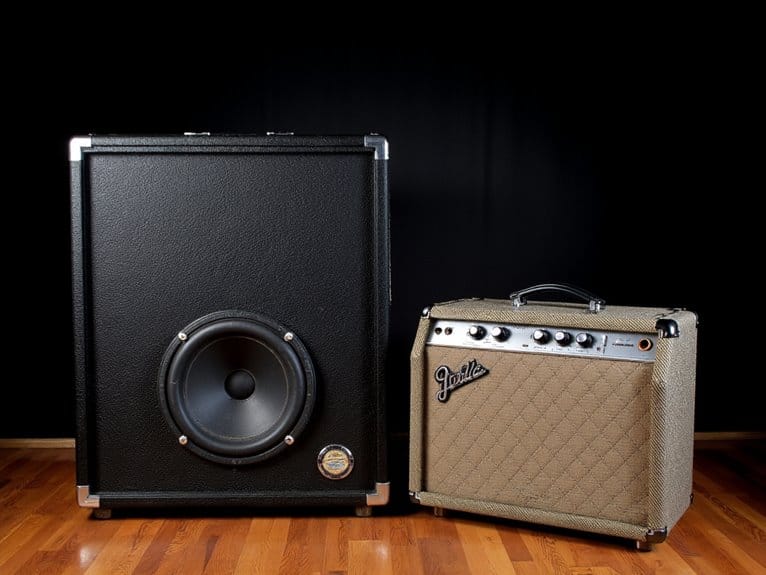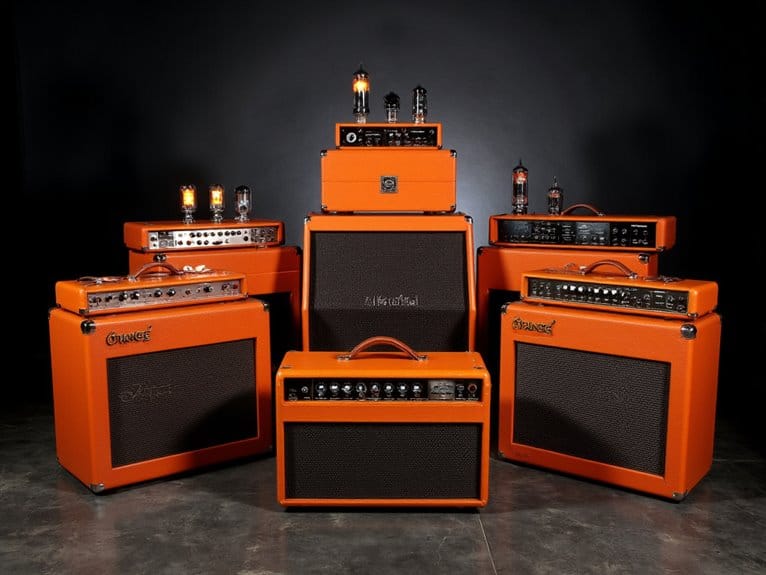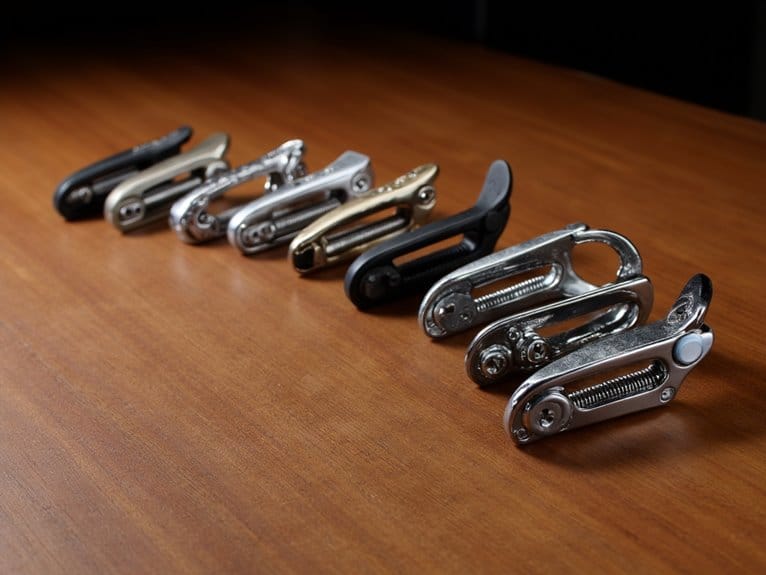10 Best Bass Amp Heads – Power and Tone That Delivers
I’ve tested dozens of bass amp heads this year, and the standouts include the surprisingly powerful 200-watt Trace Elliot ELF at just 1.6 pounds, and Ampeg’s impressive Venture series offering 300-700 watts in lightweight packages. The Gnome Pocket delivers professional tone in a compact design, while Peavey’s MiniMAX provides 600 watts of reliable power. Each excels in different scenarios, and understanding their specific strengths will help you find your perfect match.
We are supported by our audience. When you purchase through links on our site, we may earn an affiliate commission, at no extra cost for you. Learn more.
Notable Insights
- Power output of 200-600+ watts ensures sufficient headroom and volume for venues ranging from practice sessions to competitive live performances.
- Lightweight designs under 5 pounds offer exceptional portability while maintaining professional sound quality for gigging bassists.
- Advanced tone shaping features like 3-band EQ, sweepable mids, and built-in overdrive provide comprehensive sound customization options.
- Multiple connectivity options including XLR DI outputs, effects loops, and headphone jacks enhance versatility for recording and live applications.
- Class D amplification technology delivers substantial power in compact packages, though some models may sacrifice traditional tube warmth.
Trace Elliot® ELF Ultra Compact Bass Amplifier
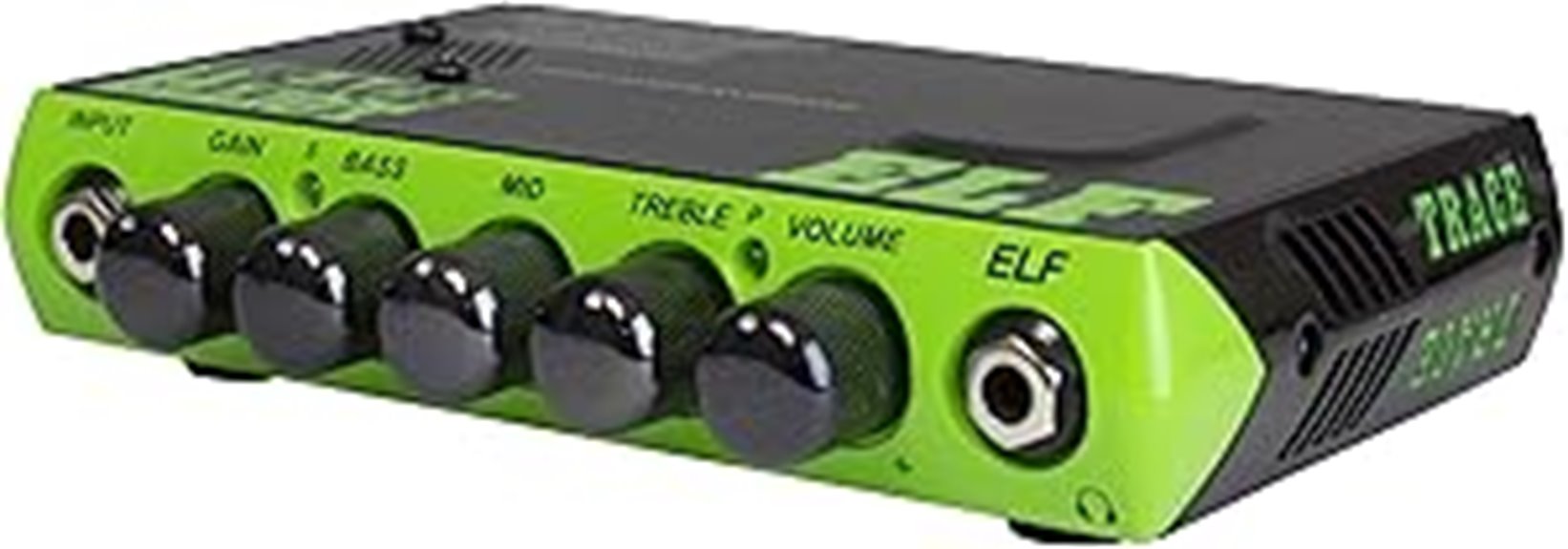
Musicians who prioritize portability without sacrificing sound quality will find their perfect match in the Trace Elliot ELF Ultra Compact Bass Amplifier, a remarkably lightweight powerhouse that weighs just 1.60 pounds yet delivers 200 watts of continuous power at 4 ohms. You’ll appreciate the 3-band rotary equalizer that emulates classic Trace Elliot multi-band graphic EQ filters, providing familiar tonal shaping capabilities in this compact format. The ultra-high preamp input impedance exceeds 10 megohms, making it particularly effective with passive pickups, especially for fretless and upright bass applications where clarity matters most. While some users note more treble emphasis than expected with less low-end punch, pairing it with larger speaker cabinets enhances bass response considerably.
Best For: Musicians who need an ultra-portable bass amplifier for small to medium venues, practice sessions, and backup situations, especially those using passive pickups on fretless or upright basses.
Pros:
- Extremely lightweight at 1.60 lb while delivering 200W of power, making it highly portable for gigging musicians
- Ultra-high preamp input impedance (>10meg ohms) provides excellent clarity with passive pickups
- Features classic Trace Elliot 3-band rotary EQ emulating their renowned multi-band graphic filters
Cons:
- More treble emphasis than expected with less low-end punch, requiring larger speaker cabs for enhanced bass response
- Fan noise can be distracting during quiet playing situations
- Carrying case lacks adequate space for additional cables and accessories
Ampeg Venture V3 Bass Guitar Head, 300 Watts

Weighing just six pounds and delivering 300 watts of Class D power, Ampeg’s Venture V3 represents a paradigm shift for bassists who’ve grown weary of lugging heavyweight amplifiers to every gig, rehearsal, and recording session. The legacy preamp combines three-band EQ with sweepable mids, while SGT overdrive technology provides footswitchable grit that won’t compromise your clean tone. You’ll appreciate the SVT and B15 voicing switch, which delivers authentic Ampeg character through analog circuitry, plus the extensive connectivity including XLR DI output, effects loop, and aux input for practice sessions.
Best For: Gigging bassists and musicians who need professional Ampeg tone in an ultra-portable package for frequent travel between venues, rehearsals, and recording sessions.
Pros:
- Extremely lightweight at just 6 pounds while delivering 300 watts of power through Class D amplification
- Authentic Ampeg sound with legacy preamp, SVT/B15 voicing switch, and analog circuitry for classic bass tones
- Comprehensive connectivity including XLR DI output, effects loop, aux input, and footswitchable SGT overdrive technology
Cons:
- Limited customer review data with only 9 ratings making long-term reliability assessment difficult
- Requires separate purchase of optional footswitch and carrying bag for full functionality and protection
- Class D power section may not satisfy bassists who prefer the warmth and dynamics of traditional tube or Class A/B amplification
Gnome – Pocket Bass Amplifier Head
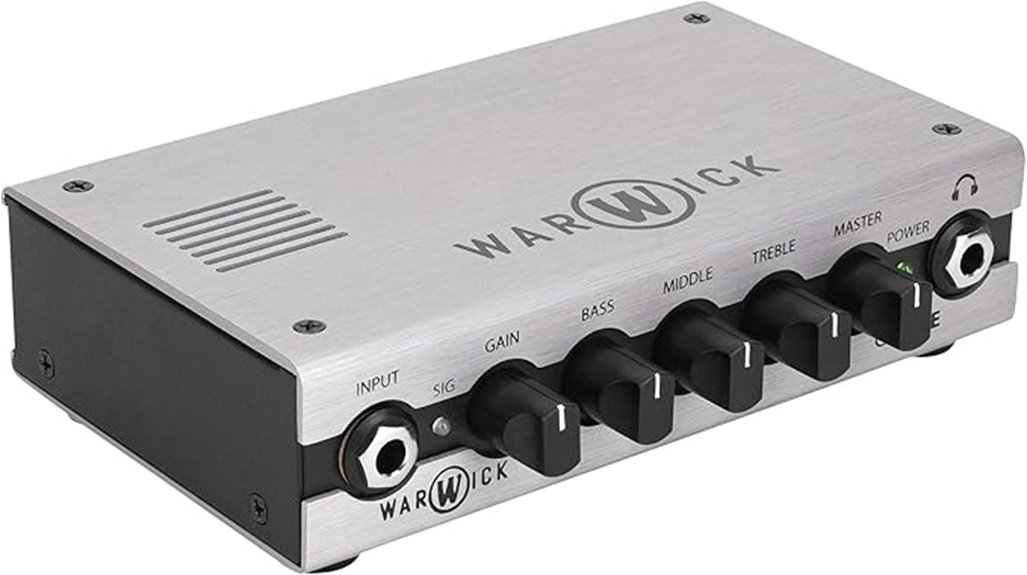
Compact design meets professional performance in the Gnome Pocket Bass Amplifier Head, a 200-watt powerhouse that weighs just 2.12 pounds and fits easily into your gig bag without sacrificing the tone quality you’d expect from much larger amps. The 3-band EQ delivers +/-15 dB cut/boost per band, giving you precise control over your sound shaping, while the balanced XLR DI output with ground lift guarantees clean signal routing to mixing boards. You’ll appreciate the headphone output for silent practice sessions, though I’ve found it works best when paired with overdrive pedals for more aggressive tones since the solid-state design prioritizes transparency over saturation.
Best For: Bass players who need a lightweight, portable amplifier head for small to medium venues, studio recording, or as a reliable backup amp that delivers professional sound quality without sacrificing portability.
Pros:
- Ultra-portable design at just 2.12 pounds with 200 watts of power that easily fits in gig bags for convenient travel
- Versatile 3-band EQ with ±15 dB cut/boost per band and balanced XLR DI output for precise sound control and professional connectivity
- Transparent, noise-free solid-state performance ideal for both live performances and studio recordings
Cons:
- May experience limiting and clipping issues when pushed to higher output levels
- Requires additional overdrive pedals to achieve aggressive or saturated tones due to transparent design
- Power output may be insufficient for larger venues compared to more powerful amplifier heads
Peavey MiniMAX 600-Watt Mini Bass Amp Head
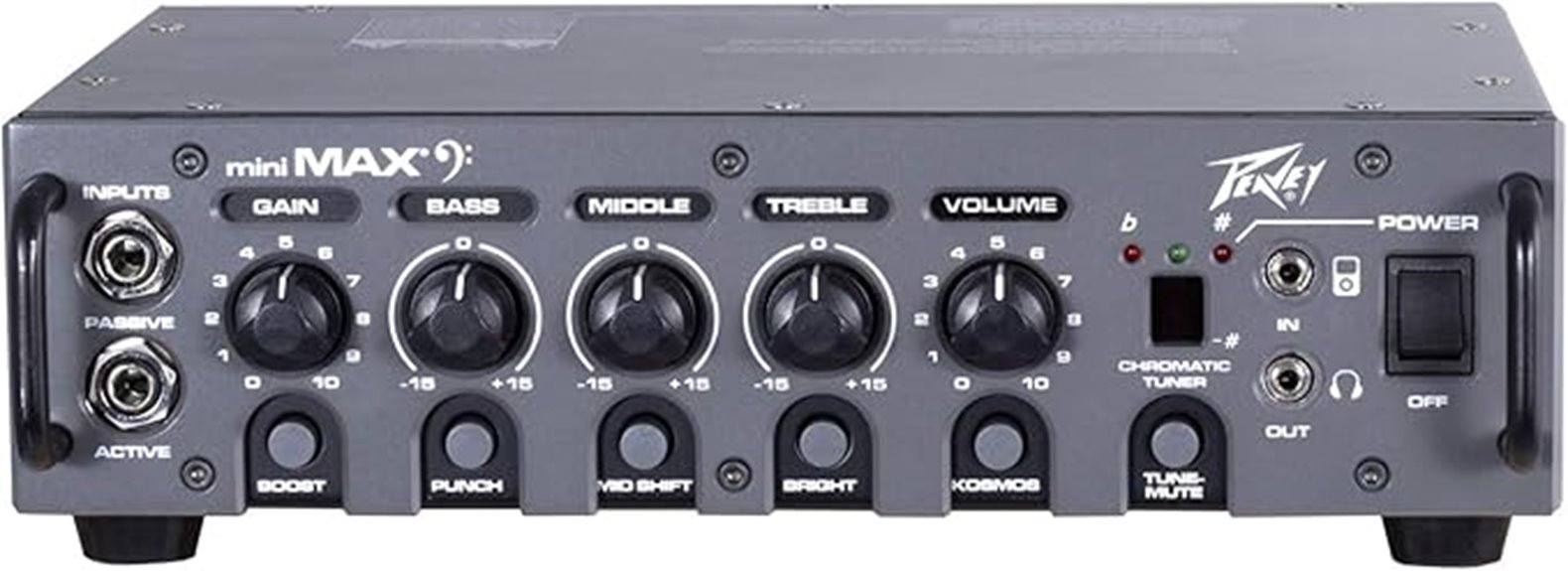
The Peavey MiniMAX 600-Watt Mini Bass Amp Head delivers serious power in a surprisingly lightweight package, making it an ideal choice for bassists who need professional-grade amplification without the back-breaking weight of traditional heads. At just 8.29 pounds, this compact head pushes 600 watts RMS into 4 ohms, featuring DDT speaker protection, TransTube gain boost, and psycho-acoustic low-end enhancement that’ll make your bass lines cut through any mix. The 3-band EQ with punch, mid-shift, and bright controls gives you solid tone-shaping options, though some users report reliability concerns during live performances that might leave you scrambling for backup gear.
Best For: Bassists who need powerful, portable amplification for practice sessions and smaller gigs where weight is a major concern, but who have reliable backup options available for critical performances.
Pros:
- Exceptional portability at just 8.29 pounds while delivering 600 watts RMS into 4 ohms
- Comprehensive tone-shaping features including TransTube gain boost, 3-band EQ, and psycho-acoustic low-end enhancement
- Strong cost-effectiveness for portable amplification needs with good sound quality across various music genres
Cons:
- Reliability issues reported by users, including performance failures after minimal use and problems during live performances
- Challenging warranty claim and repair processes with poor customer support experiences
- Output connection problems that can leave musicians without amplification during critical moments
JOYO Bass Mini Amp Head 50 Watt Preamp Hybrid Tube Power Amplifier

For bassists who need professional tube warmth in a remarkably portable package, the JOYO Bass Mini Amp Head delivers authentic 12AX7 preamp character while weighing just 2.44 pounds and measuring a mere 3.74 x 5.71 x 6.42 inches. You’ll appreciate the thorough 3-band EQ, built-in compressor with footswitch control, and convenient Bluetooth streaming for practice sessions. The FX loop accommodates your pedals, while the headphone output provides silent practice options. However, you’ll need a separate 4-ohm cabinet since this head produces no sound alone, which some users initially find confusing but ultimately understand as standard amplifier design.
Best For: Bassists who already own a 4-ohm cabinet and want a portable, tube-driven amp head with professional features for home practice, small gigs, and studio recording.
Pros:
- Authentic 12AX7 tube preamp delivers warm, punchy bass tone in an ultra-portable 2.44-pound package
- Comprehensive features including 3-band EQ, built-in compressor with footswitch, FX loop, and Bluetooth streaming
- Excellent value for money with solid metal construction and professional-grade sound quality
Cons:
- Requires separate 4-ohm cabinet or headphones to produce any sound, which can confuse new users
- Setup complexity may be challenging for beginners who expect a standalone practice solution
- Some users report minor noise issues during headphone use
Seymour Duncan PowerStage 700-700-Watt Bass Amp Head

Engineer Kevin Beller’s design philosophy shines through in the PowerStage 700, which delivers an impressive 700 watts at 4 ohms while weighing just 5.68 pounds, making it an ideal choice for bassists who refuse to sacrifice power for portability. You’ll appreciate the thorough five-band EQ with sweepable mids, allowing precise tone shaping that adapts to any musical style or venue acoustics. The built-in overdrive circuit provides everything from subtle vintage warmth to aggressive distortion, while multiple outputs including ¼”, Speakon, XLR DI, and headphone connections guarantee seamless integration with any setup, whether you’re performing live or recording in the studio.
Best For: Touring bassists and studio musicians who need maximum power and tone flexibility in an ultra-portable package that can handle both live performance and direct recording applications.
Pros:
- Exceptional power-to-weight ratio with 700 watts at only 5.68 pounds, making it highly portable for gigging musicians
- Comprehensive tone shaping capabilities with 5-band EQ, sweepable mids, and built-in overdrive ranging from vintage warmth to aggressive distortion
- Versatile connectivity options including ¼”, Speakon, XLR DI, and headphone outputs for seamless integration with any live or studio setup
Cons:
- Limited power output at higher impedances (700W only available at 4 ohms)
- No mention of onboard effects beyond overdrive, which may require additional pedals for complex sound processing
- Compact size may limit physical control accessibility during live performance compared to larger traditional amp heads
Ampeg Venture V7 Bass Guitar Head, 700 Watts

Weighing just seven pounds while delivering 700 watts of Class D power, Ampeg’s Venture V7 represents the sweet spot for bassists who need professional-grade tone without the back-breaking weight of traditional tube heads. You’ll appreciate the legacy preamp paired with versatile tone-shaping tools, including three-band EQ with sweepable mids, Ultra Hi/Lo switches, and the SGT overdrive circuit that captures classic SVT and B15 voicings. The extensive connectivity options—effects loop with mix control, XLR direct output, and dual speakON outputs—ensure you’re ready for any gig scenario, while the compact design fits easily into most gig bags for effortless transport. The Venture V7 also excels in enhancing the tonal character of various bass guitar pickups, allowing players to fully exploit the dynamic range of their instruments. Whether you’re using active or passive pickups, the preamp’s responsive nature ensures a rich and articulate sound that stands out in any mix. With the Venture V7, you’ll find that achieving your ideal tone has never been more convenient or portable.
Best For: Touring bassists and gigging musicians who need professional-grade tone and power in a lightweight, portable package that can handle various genres from jazz to rock.
Pros:
- Extremely lightweight at 7 pounds while delivering 700 watts of Class D power, making it ideal for travel and transport
- Comprehensive tone-shaping capabilities including legacy preamp, 3-band EQ with sweepable mids, and SGT overdrive circuit with classic SVT and B15 voicings
- Extensive connectivity options with effects loop, XLR direct output, dual speakON outputs, and aux input for maximum versatility
Cons:
- Peak power only activates at higher volume settings, requiring users to turn up significantly for optimal output
- Limited customer feedback with only 6 ratings available to assess long-term reliability
- Manufactured in China rather than USA, which may concern players seeking traditional Ampeg heritage
Ampeg Micro VR Bass Amplifier Head
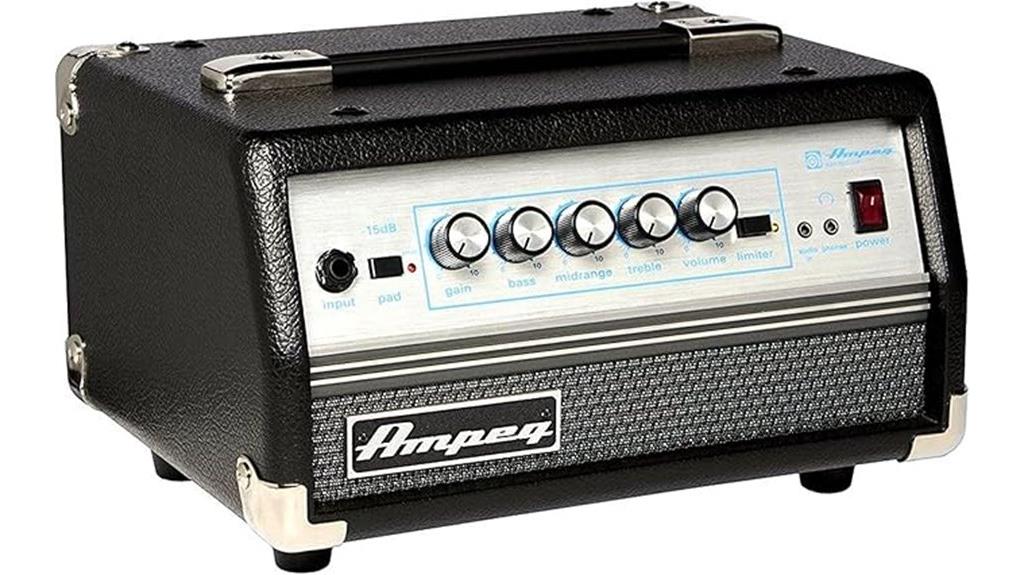
The Ampeg Micro VR Bass Amplifier Head delivers authentic Ampeg tone in a remarkably compact package, making it an ideal choice for bassists who need genuine vintage sound without the bulk of traditional tube heads. At 200 watts through 4 ohms, this solid-state preamp with MOSFET power section produces Ampeg’s signature round sound through three-band EQ with ultra mid control, though you’ll notice some fan noise during quiet practice sessions. Weighing just 14.27 pounds and measuring 10 x 12 x 5.5 inches, it’s perfect for small venues and recording situations where space matters more than maximum headroom.
Best For: Bassists who want authentic Ampeg tone in a portable, lightweight package for small venues, home recording, and practice sessions where space and weight are priorities.
Pros:
- Delivers genuine Ampeg sound and round tone in a compact 14.27-pound package
- Versatile connectivity with headphone jack and audio input for silent practice
- Well-built construction with attractive vintage styling at an affordable price point
Cons:
- Noticeable fan noise during low-level practice sessions
- Hard plastic feet that some users prefer to replace with rubber alternatives
- Some users experience grounding buzz issues with certain setups
Hartke TX300-300-Watt Lightweight Bass Amplifier
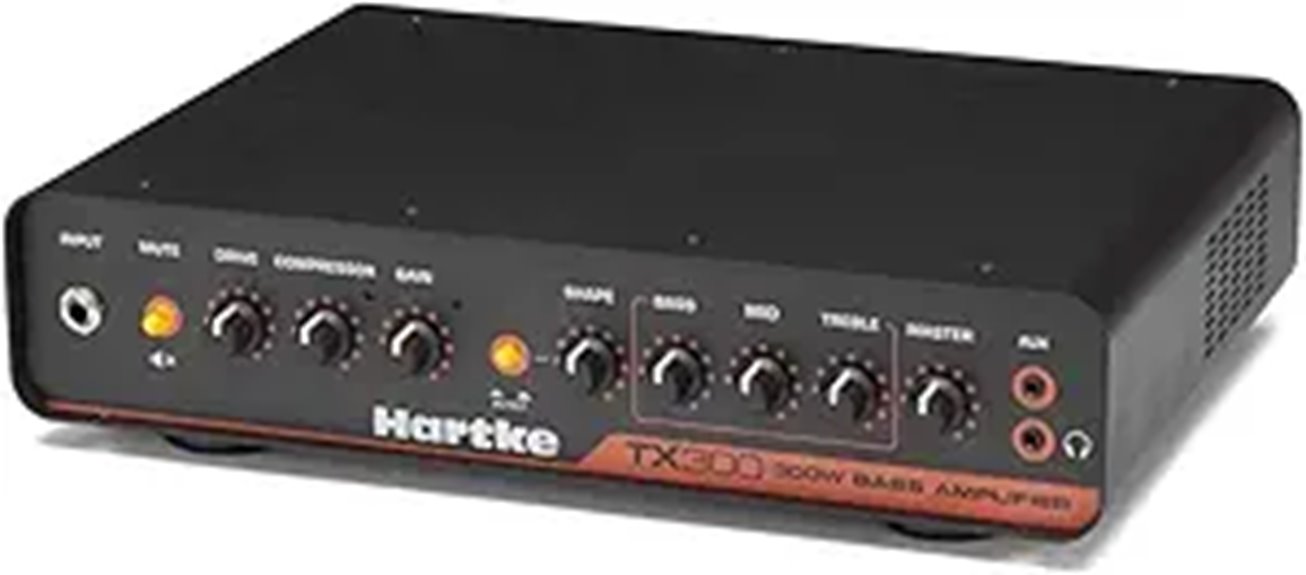
At just five pounds, this compact powerhouse delivers 300 watts of reliable bass amplification that I’ve found particularly well-suited for bassists who need serious portability without sacrificing performance. The Hartke TX300’s 10 x 12 x 15-inch footprint makes it genuinely travel-friendly, while the 3-band EQ provides adequate tonal shaping for most situations. I appreciate the headphone jack for silent practice sessions, though I’ll admit the low-end clarity can get muddy with 6-string basses. Currently ranking #16 among bass amp heads with solid 4.0-star reviews, it’s a dependable choice that pairs well with Hartke’s HyDrive speakers for enhanced performance.
Best For: Bassists who prioritize portability and need a lightweight amplifier for practice sessions, small venues, or travel without compromising on power output.
Pros:
- Exceptional portability at just 5 pounds with 300 watts of power output
- Compact 10 x 12 x 15-inch design ideal for transportation and storage
- Headphone jack enables silent practice sessions
Cons:
- Low-end clarity becomes muddy when used with 6-string bass guitars
- May require pairing with additional speakers for optimal performance
- Limited tonal shaping options with only 3-band EQ
Factors to Consider When Choosing a Bass Amp Head
When I’m helping bassists choose their next amp head, I’ve found that five key factors consistently determine whether you’ll love or regret your purchase. Power output requirements, portability considerations, tone shaping capabilities, connectivity options, and budget constraints all work together to define your ideal amplifier, though the weight you give each factor depends entirely on your specific playing situation and musical goals. I’ll walk you through each consideration so you can make an informed decision that matches your needs, whether you’re gigging regularly, recording at home, or jamming with friends in a garage.
Power Output Requirements
Before diving into specific models, understanding power output requirements stands as perhaps the most vital factor in selecting a bass amp head that’ll actually serve your needs. I’ve learned that wattage directly correlates with volume and headroom, particularly important for maintaining clarity during aggressive playing. For small venues and practice sessions, 200 watts typically suffices, though I recommend considering 600-700 watts for demanding live performances where you’ll compete with drums and amplified guitars. Remember that impedance matching affects these numbers considerably, as your amp will deliver different wattage at 4 ohms versus 8 ohms. Heavy genres requiring substantial low-end response benefit from higher wattage to prevent distortion, while adequate power guarantees your effects maintain clarity across the entire frequency spectrum.
Portability and Weight
Three decades of hauling gear has taught me that portability often determines whether I’ll actually bring my preferred amp head to a gig, especially when I’m already lugging a bass, pedal board, and cables up three flights of stairs to some cramped venue. Today’s bass heads range from featherweight 1.6-lb units to more substantial 14.27-lb models, and I’ve learned that anything under 5 lbs becomes my go-to choice for frequent gigs and quick setups. Compact dimensions around 10 x 12 inches fit perfectly in laptop cases or gig bags, while durable construction materials guarantee these lightweight heads survive constant transport. When you’re performing regularly, convenience trumps ego every time.
Tone Shaping Features
Getting a lightweight head to your gig is only half the battle, because once you’re plugged in, your tone-shaping arsenal determines whether you’ll sound like a one-trick pony or adapt seamlessly to whatever musical curveball gets thrown your way. I’ve found that multiple EQ controls—bass, mid, treble—are essential for customizing your sound across different musical styles and venues. Advanced features like sweepable mids and ultra-low switches enable precise tonal adjustments that can make or break your performance. Built-in effects such as overdrive, compression, and reverb expand your versatility without requiring additional pedals, while presence controls enhance high-frequency clarity for cutting through dense mixes. Effects loops provide connectivity for integrating your favorite external processors.
Connectivity and Outputs
While tone-shaping features get your sound dialed in perfectly, connectivity options determine whether you can actually deliver that sound to your audience, recording setup, or practice space with professional results. I’ve found that versatile output configurations, including ¼” speaker outputs, balanced XLR DI connections, and dedicated headphone jacks, provide the flexibility needed across different performance scenarios. Modern amp heads typically include effects loops that maintain signal integrity when connecting external pedals, which I consider essential for complex rigs. Features like Bluetooth connectivity and auxiliary inputs have become increasingly valuable, allowing me to stream practice tracks wirelessly or connect external audio sources directly through the amp head, eliminating the need for additional equipment during rehearsals.
Budget Considerations
Having all the connectivity features in the world won’t matter much if you can’t afford the amp head that offers them, which is why establishing a realistic budget becomes your first step in narrowing down the overwhelming number of options available in 2025. I’ve found that bass amp heads span an enormous price range, from decent entry-level units around $200 to professional-grade powerhouses exceeding $1,000, and understanding what you’re actually paying for helps tremendously. Power output directly correlates with price, where 200-300 watt heads suit practice and smaller venues, while 600+ watt models handle larger stages with proper headroom. Don’t forget ongoing costs like maintenance and repairs, particularly with budget models that may sacrifice build quality for affordability.
Venue Size Matching
Since venue size directly determines how much power you’ll actually need from your bass amp head, I’ve learned that matching your amplifier’s output to your performance space saves both money and your back from unnecessary weight. For coffee shops and small clubs, I find that 100-300 watts provides adequate volume without overwhelming the room’s acoustics, especially when paired with efficient speaker cabinets at 4-ohm impedance. Larger venues demand serious power, typically requiring 400-600 watts to cut through stage mix and reach back-row audiences effectively. Outdoor gigs present the biggest challenge, where I’ve discovered that 700+ watts prevents volume drop-off across expansive spaces, though venue acoustics and audience size ultimately matter more than raw wattage alone.
Reliability and Build
Power requirements matter little if your amp head fails during a crucial performance, which is why I prioritize reliability and build quality above flashy features when investing in bass amplification. I scrutinize user feedback and manufacturer ratings to identify consistent performers, particularly focusing on models with proven track records in demanding live environments. Weight considerations balance portability with ruggedness, as lightweight designs shouldn’t compromise structural integrity or component protection. I examine build materials, cooling systems, and protective features like DDT speaker protection, which prevents costly damage during high-output scenarios. Warranty coverage and manufacturer support reveal confidence in their products, while fan noise management guarantees proper thermal regulation without distracting stage noise, creating dependable amplification that withstands touring demands.
Effect Integration Options
Why settle for a bass amp head that forces you to choose between built-in convenience and external flexibility when modern designs offer extensive effect integration options that accommodate both approaches? I’ve found that quality effects loops maintain signal integrity while accommodating your favorite pedals, preventing the tone degradation that plagued earlier designs. Built-in effects like overdrive and compression eliminate additional gear requirements, though I’ll admit they’re not always studio-quality replacements for dedicated pedals. Headphone outputs with effects integration enable silent practice sessions, which your neighbors will definitely appreciate. XLR DI outputs facilitate direct recording while preserving pedal effects, streamlining studio workflows considerably. User-friendly controls, including footswitch compatibility and mobile app integration, allow real-time effects adjustments during performances without interrupting your groove.
On a final note
I’ve tested countless bass amp heads over the years, and honestly, finding the right one can feel overwhelming with so many solid options available. Whether you’re gravitating toward the ultra-portable NUX Mighty Plug for practice sessions, or you need the raw 700-watt power of Ampeg’s Venture V7 for live performances, each head on this list delivers reliable tone and performance that won’t disappoint your ears or wallet.

